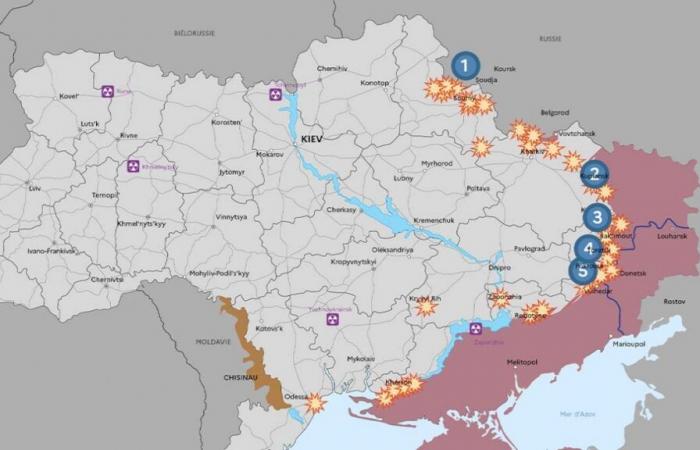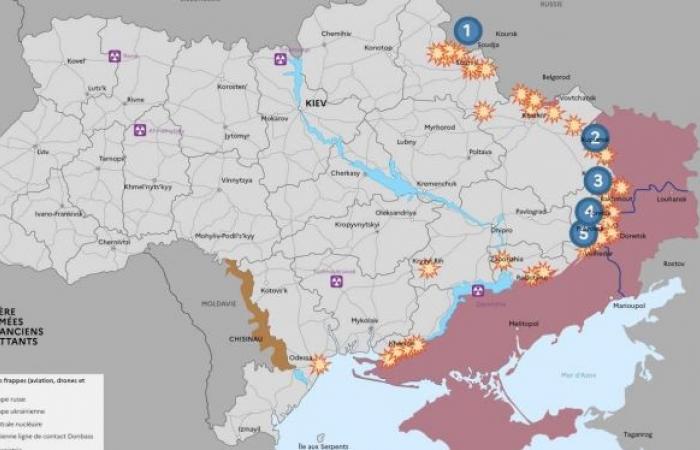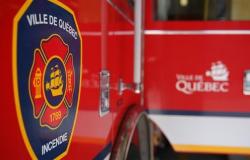Northeast Front under pressure (1)
In Kharkiv and Sumy oblasts, the situation is similar. In the Soudja sector, the Ukrainian counterattack of October 8 did not allow the lines to advance. The Ukrainian Armed Forces failed to retake positions, and the front stabilized, leaving the FAFR with the initiative. This unfavorable status quo is symptomatic of a loss of dynamism on the Ukrainian side, which sees its attempts to repel the enemy ending in failure.
This stagnation of the North-Eastern front shows the inability of the FAU to re-establish offensive momentum against a Russia which, despite human and material losses, continues to concentrate its efforts on several strategic axes.
Eastern Front: offensives and counter-offensives (2)(3)(4)
In the Luhansk oblast, the situation is contrasted. The Kupiansk sector (2) sees a continuous advance of the FAFR, which progresses towards the South, towards Sinkivka. On the other hand, the FAU managed to regain some initiative in the Siversk sector (3)where they progress towards Verkhnomanske. This counterattack, however, remains limited, not allowing real strategic breakthroughs.
Further south, the FAU finds itself in difficulty in the Toretsk sector (4)where Russian forces continue to advance in open terrain west of the town of Niou York, in the direction of Valentinivka. This axis is crucial, because it could open the way for further Russian advances if the Ukrainian defense were to give way.
Southern Front: Russian forces strengthen their control (5)
In the Donetsk oblast, fighting remains intense. In Kurakhove, Russian forces are advancing in the town of Ostrivske, making the Ukrainian position increasingly difficult to defend. Furthermore, east of Selidove, fighting continues as the FAFR advances along the railway line towards Pokrovsk, a strategic area for both camps.
In the Velika Novosilka sector, Russian forces also recaptured the town of Levadne, confirming their advance in this part of the southern front. The reconquest of this area by Russian forces further weakens the Ukrainian position in the south of the country.
South-West Front: status quo in Kherson
In Kherson Oblast, the situation remains unchanged. Both camps maintain their respective positions, with little significant progress. This region nevertheless remains crucial for both armies, because it controls access to the Dnipro River and strategic lines of communication.
An ambitious victory plan
In parallel with developments on the ground, Ukrainian President Volodymyr Zelensky presented his “victory plan” on October 16, 2024. This plan, which he hopes to see completed by 2025, excludes any territorial concession to Russia and calls for rapid accession of Ukraine to NATO. This initiative was unveiled on the eve of the NATO ministerial meeting in Brussels, where discussions on Ukraine’s integration into the Alliance are expected to continue.
Zelensky insisted that Russia must be forced to participate in a peace summit, scheduled for November, although the feasibility of that meeting remains unclear. In addition, he called on his Western allies to lift restrictions on the use of long-range weapons and increase Ukraine’s strike capabilities deep into Russian territory.
American military support
In response to recent developments, US President Joe Biden announced new military aid of $425 million, mainly intended to strengthen Ukraine’s anti-aircraft defense, particularly with a view to protecting civilian infrastructure against Russian bombing. This support also includes armor and artillery, crucial equipment as fighting intensifies on several fronts.
However, despite this international aid, the situation on the ground remains critical. Russia continued its advances in several regions, including the capture of the villages of Nevské and Krasniy Yar in Luhansk Oblast, strategic positions in Moscow’s ongoing campaign to control eastern Ukraine.
Worrying progress on the Southern front
The FAU are also under strong pressure in the south of the country. At Kurakhove, Russian forces advanced into Ostrivske, threatening the Ukrainian position. Further east, in the Donetsk oblast, fighting for control of Pokrovsk continues as the FAFR advances along a strategic railway line.
The recapture of Levadne in the Velika Novosilka sector by Russian forces strengthens Moscow’s dominance in this key region, potentially paving the way for further advances westward. The situation in the south remains unstable, with constant bombing and power shortages in Kherson and Mykolaiv due to incessant Russian drone strikes.
Despite Ukraine’s diplomatic and military efforts, Russia maintains the strategic advantage on the ground. While Western allies continue to support kyiv with arms deliveries and increased diplomatic pressure, Russian advances and the FAU’s underperformance illustrate a conflict that is getting bogged down. The coming weeks, particularly with the presentation of Zelensky’s victory plan and the meetings in Brussels, will be decisive for the future of this devastating war.









